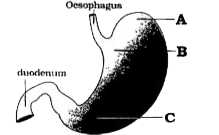Draw the sketch of anatomical regions of human stomach and label any four parts in it.
Step-by-Step Solution:
1. Draw the Outline of the Stomach: Begin by sketching a J-shaped outline to represent the human stomach. This shape is crucial as it visually represents the anatomical structure.
2. Label the Regions: Divide the stomach into its four main anatomical regions:
- Cardiac Region: This is where the esophagus connects to the stomach. It is located at the top of the stomach.
- Fundus: This is the uppermost part of the stomach, above the cardiac region. It is often where gases accumulate.
- Body: This is the largest part of the stomach where most of the digestion occurs. It is located below the fundus and cardiac region.
- Pylorus: This is the lower part of the stomach that connects to the small intestine (duodenum). It contains a valve that regulates the passage of food into the small intestine.
3. Label the Sketch: Clearly label each of the four regions on your sketch:
- Cardiac Region
- Fundus
- Body
- Pylorus
4. Add Additional Details (Optional): You can add arrows or lines to indicate the direction of food flow from the esophagus to the stomach and then to the small intestine.
- Cardiac Region: This is where the esophagus connects to the stomach. It is located at the top of the stomach.
- Fundus: This is the uppermost part of the stomach, above the cardiac region. It is often where gases accumulate.
- Body: This is the largest part of the stomach where most of the digestion occurs. It is located below the fundus and cardiac region.
- Pylorus: This is the lower part of the stomach that connects to the small intestine (duodenum). It contains a valve that regulates the passage of food into the small intestine.
- Cardiac Region
- Fundus
- Body
- Pylorus
Topper's Solved these Questions
- Digestion and AbsorptionBOOK - CBSE COMPLEMENTARY MATERIALCHAPTER - Digestion and AbsorptionEXERCISE - Short Answer Questions-I
7 Videos
- CLASSIFICATION BOOK - CBSE COMPLEMENTARY MATERIALCHAPTER - CLASSIFICATION EXERCISE - LONG ANSWER QUESTIONS
2 Videos
- EXCRETORY PRODUCTS AND THEIR ELIMINATION BOOK - CBSE COMPLEMENTARY MATERIALCHAPTER - EXCRETORY PRODUCTS AND THEIR ELIMINATION EXERCISE - Short Answer Questions-II
2 Videos
Similar Questions
Knowledge Check

Anatomical regions of human stomach areAA- Fundus, B - Pyloric, C - CardiacBA -Cardiac, B - Fundus, C - PyloricCA - Fundus, B - Cardiac, C - PyloricDA-Pyloric, B - Fundus, C-CardiacThe given diagram represent anatomical region of human stomach.Identify A, B and C
 AA-Fundus, B-Cardiac, C-PyloricBA-Pyloric, B-Fundus, C-CardiacCA-Cardiac,, B-Fundus,C-PyloricDA-Fundus, B-Pyloric,C-Cardiac
AA-Fundus, B-Cardiac, C-PyloricBA-Pyloric, B-Fundus, C-CardiacCA-Cardiac,, B-Fundus,C-PyloricDA-Fundus, B-Pyloric,C-Cardiac
Draw a diagram of the longitudinal section of a mature anatropous ovule and label any ten parts in it.
View SolutionDraw a diagram to show the structure of a neuron with myelinated axon and label any six parts in it .
View SolutionSketch and label L.S. of human kidney.
View Solution
Observe the sketch of stirred - tank bioreactor and label the part A,B,C and D.
View SolutionDraw a diagram of a male gametophyte of an angiosperm. Label any four parts. Why is Sporopollenin considered the most resistant organic material ?
View SolutionSketch and label ventral view of human heart .
View Solution
